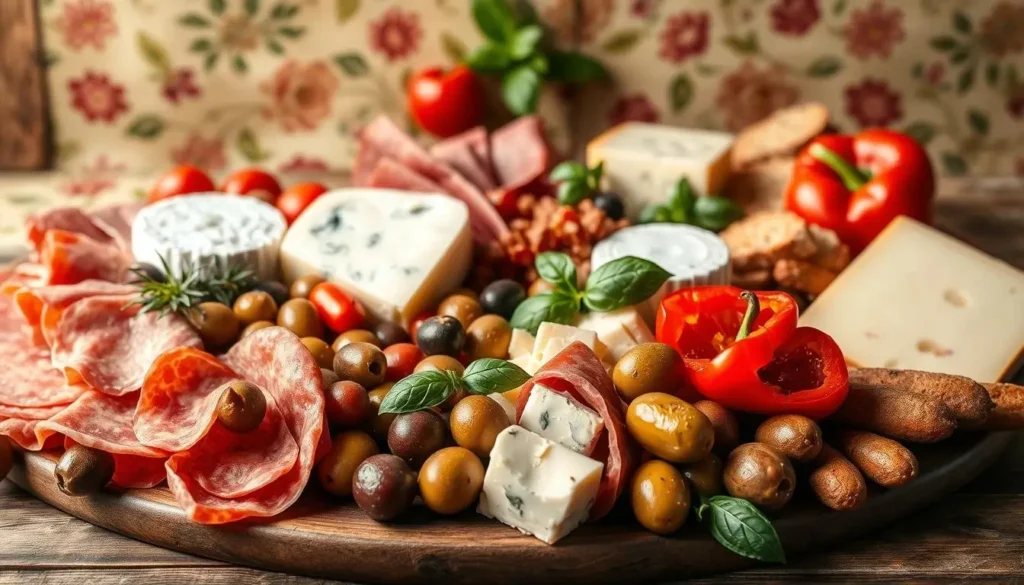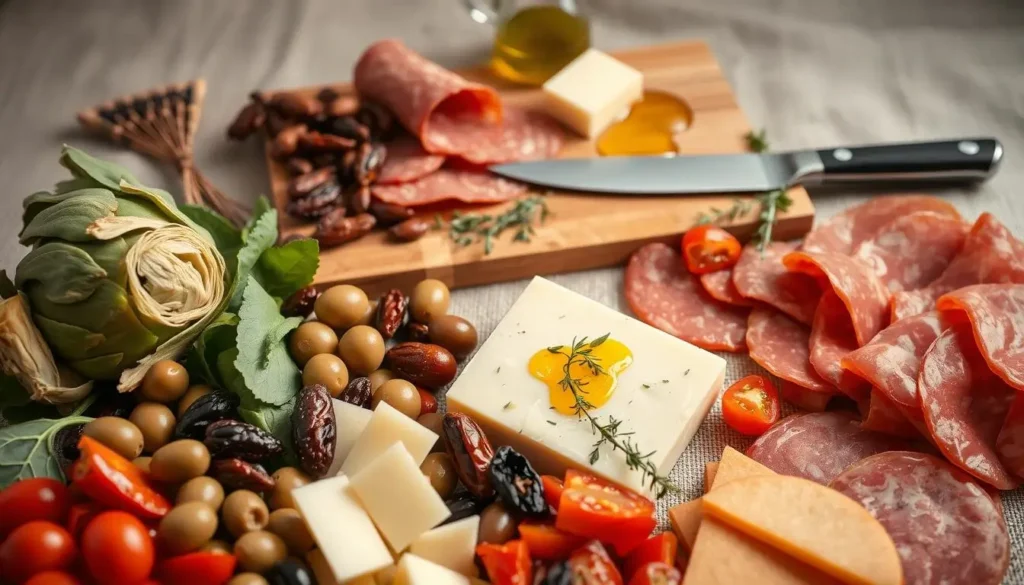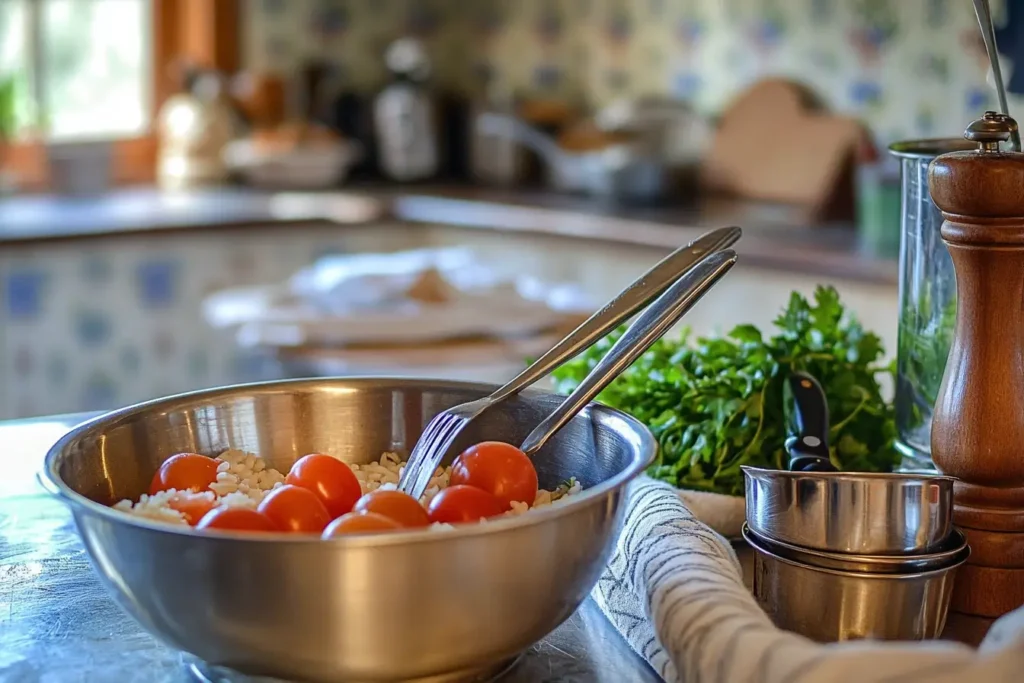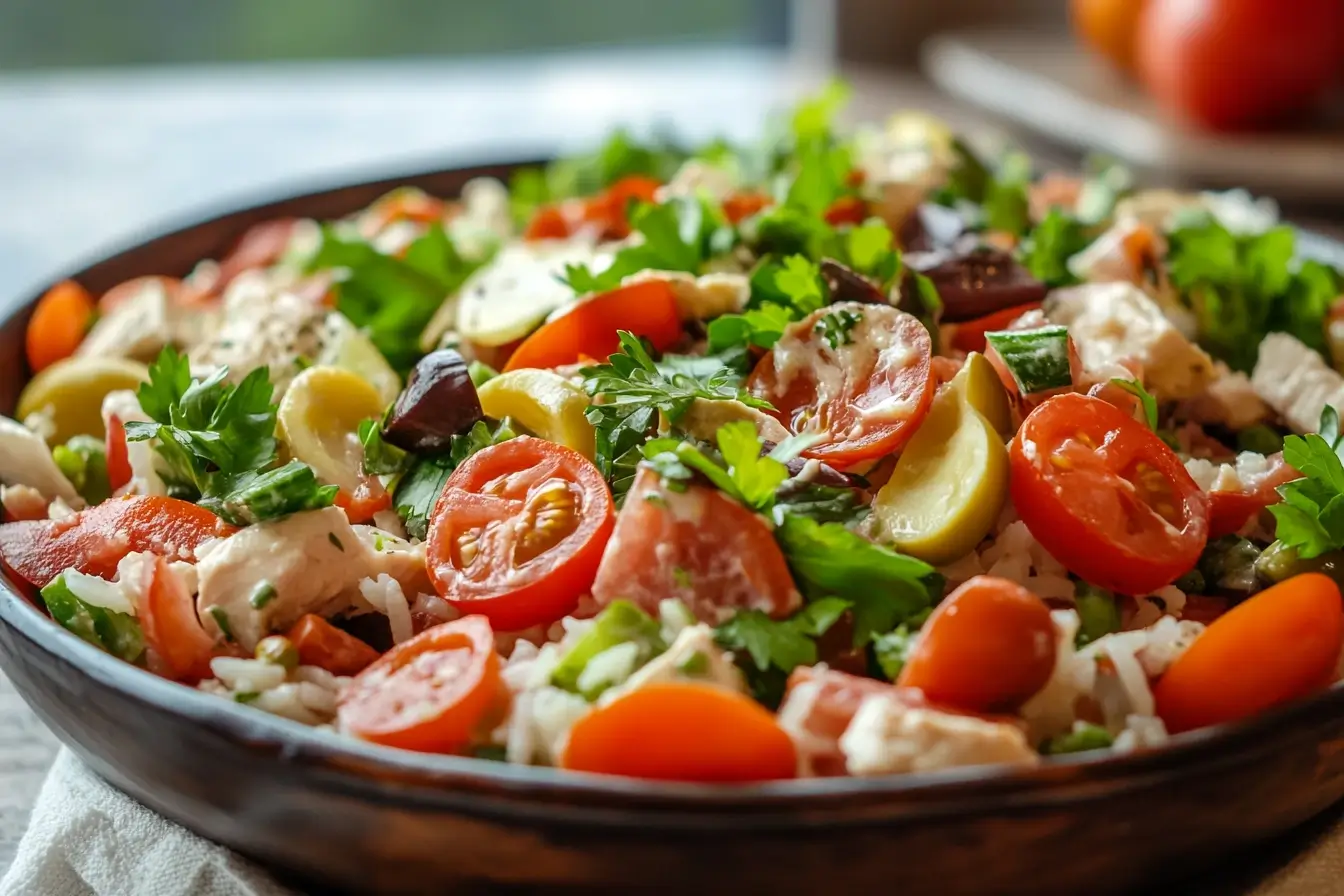Fresh artichoke hearts and high-quality olive oil form the foundation of this dish, adding richness and depth. Prepping takes just minutes, letting you focus on layering flavors instead of complicated techniques. Simply combine sliced meats, marinated vegetables, and cubes of semi-hard cheese in a large bowl.
The peppery Dijon dressing ties everything together, balancing saltiness with a bright, herb-infused finish. Whether you’re hosting a dinner party or packing lunch, this dish adapts effortlessly. It’s visually striking, nutritionally balanced, and packed with textures that keep every bite interesting.
Key Takeaways
- Combines Italian cured meats, cheeses, and marinated vegetables for bold flavor
- Ready in under 20 minutes with minimal prep work
- High-quality olive oil and fresh artichoke hearts enhance taste
- Perfect for casual meals or entertaining guests
- Homemade dressing adds a zesty, peppery kick
- Easily customizable based on ingredient preferences
Discovering the Antipasto Salad Recipe
This dish celebrates the bold contrasts of Italian cuisine – salty, tangy, and herbaceous flavors in every forkful. By balancing cured meats with marinated vegetables, it transforms pantry staples into something extraordinary. Let’s explore why this combination has become a modern classic.

What Makes This Dish a Crowd-Pleaser?
The magic lies in its ingredients. Meaty artichoke hearts add earthy depth, while briny olives provide bursts of saltiness. A precise cup measurement for components like cheeses ensures every serving delivers consistent flavor. The large serving bowl presentation lets guests customize their portions, making it ideal for shared meals.
Quality matters most with the olive selection. Kalamata or Castelvetrano varieties honor traditional recipes while offering distinct textures. These elements create a symphony of tastes that appeal to both adventurous eaters and traditionalists.
The Italian Heritage Behind the Dish
Rooted in antipasto traditions, this meal starter evolved into a hearty main course. Early Italian cooks used preserved meats and garden vegetables to create satisfying pre-meal bites. Today’s version keeps that spirit alive through smart pairings – sharp provolone against sweet roasted peppers, or peppercorn-studded salami contrasting with mild greens.
By honoring these time-tested combinations, you bring centuries of culinary wisdom to your table. The result? A dish that feels both nostalgic and refreshingly modern.
Essential Ingredients and Equipment
The foundation of any great dish lies in its components and preparation methods. Selecting premium elements and efficient tools ensures your creation delivers authentic flavors while simplifying your workflow.
Key Salad Ingredients: Olives, Cheese, and Cured Meats
Start with Genoa salami for its peppery bite and balanced fat content. Pair it with provolone’s sharpness and fresh mozzarella’s creaminess. Kalamata olives add briny depth, while Castelvetrano varieties offer buttery contrast.

Use extra virgin olive oil with low acidity for the vinaigrette. Measure salt carefully – one teaspoon enhances without overpowering. Combine these proteins and fats to create a nutritionally complete meal that satisfies without heaviness.
Must-Have Tools for a Simple Preparation
A razor-sharp chef’s knife ensures clean cuts through cured meats and cheeses. Stainless steel mixing bowls prevent flavor transfer during prep. Use graduated teaspoons for exact seasoning ratios in the dressing.
Salad tongs with silicone grips let you toss ingredients gently. A glass jar with a tight seal emulsifies oil and vinegar perfectly. These tools transform chopping and mixing into swift, precise actions – no specialized gadgets required.
Step-by-Step Guide to Crafting Your Salad
Unlock authentic flavors by mastering two key components: the zesty dressing and strategic assembly. This method ensures every bite delivers balanced textures and bold contrasts.
Preparing the Dijon Vinaigrette
Start with 1/4 cup Champagne vinegar and 2 teaspoons Dijon mustard in a mixing bowl. Whisk vigorously while slowly drizzling in 3/4 cup extra virgin olive oil to emulsify. Fold in 1 minced shallot and 1/2 teaspoon cracked pepper for aromatic depth.

Test the consistency by dipping a lettuce leaf – it should cling lightly without pooling. Adjust with a pinch of salt or honey to balance acidity. Store in a sealed jar for up to three days.
Mixing and Assembling the Ingredients
Combine 8 oz sliced cured meats, 1 cup cubed provolone, and pre-chopped vegetables in a large bowl. Toss gently to distribute colors and textures evenly. Add dressing just before serving to maintain crunch.
Pro tip: Prep components up to 24 hours ahead, keeping greens separate. Layer ingredients vertically in clear bowls for visual appeal. Finish with a final grind of pepper to enhance the Italian-inspired profile.
Antipasto Salad Recipe: Flavor Variations and Ingredient Substitutions
Transform your culinary canvas by exploring endless combinations of fresh and preserved components. This dish thrives on flexibility—swap ingredients based on seasonal availability or dietary needs while maintaining its signature Italian character. Precision in measurements (think ounces over guesswork) ensures balanced flavors every time.
Customizing with Seasonal or Alternative Ingredients
Summer’s heirloom tomatoes bring sweetness, while winter calls for roasted squash’s earthy notes. Swap pepperoni for capicola or prosciutto to vary the meat profile. For cheese lovers, creamy burrata replaces mozzarella beautifully.
| Season | Swap | Flavor | Quantity |
|---|---|---|---|
| Spring | Asparagus tips | Crisp, grassy | 7 oz |
| Summer | Heirloom tomatoes | Sweet, juicy | 8 oz |
| Fall | Roasted squash | Nutty, rich | 10 oz |
| Winter | Citrus segments | Bright, tangy | 6 oz |
“The beauty of Italian cooking lies in its adaptability—let your market’s freshest offerings guide your creations.”
Personalizing Your Salad for Different Occasions
Arrange components on a slate platter for dinner parties, grouping items by color and texture. For quick lunches, layer ingredients in mason jars—dressing at the bottom, greens on top. Reduce pepperoni to 4 oz and double roasted vegetables for lighter versions.
Measure dressings using teaspoons for consistency across batches. Inspired by Niçoise-style plating, position ingredients separately for visual drama. Most adjustments take under 10 minutes, proving that great recipes adapt to your schedule.
Serving Suggestions and Storage Tips
Elevate your culinary creation from kitchen counter to showstopper with smart presentation and storage solutions. These strategies ensure vibrant flavors shine while extending your dish’s versatility beyond initial preparation.
Creative Plating Ideas for a Stunning Presentation
Layer crisp romaine leaves as a vibrant base for ingredients. Arrange roasted peppers and cured meats in concentric circles, creating visual rhythm. Use measured cups to portion components evenly – this maintains balance across servings.
For casual dinner gatherings, scatter bright cherry tomatoes and olives across the top. Place cheese cubes at the center as a focal point. Chilled serving bowls keep flavors fresh during extended meals.
How to Store Leftovers and Enjoy Make-Ahead Options
Cool leftovers completely before transferring to airtight containers. Separate greens from dressed ingredients to prevent sogginess. Refrigerate for up to 24 hours – marinated vegetables develop deeper flavor overnight.
Assemble dry components in advance, storing them in labeled jars. Add dressing and delicate greens just before serving. This make-ahead approach saves time without compromising texture.
Easy Gluten-Free Lunches: Quick Recipes for Busy Days
Conclusion
Bringing together fresh produce and Italian staples creates a memorable course that’s both satisfying and adaptable. You’ve learned how quality ingredients like roasted red peppers and crisp cherry tomatoes build vibrant layers of flavor. With precise tablespoons for dressing and strategic prep steps, anyone can make antipasto salad that rivals restaurant menus.
Remember the essentials: balance salty meats with sweet cherry tomatoes, and let sharp red onion slices add bite. The beauty lies in customization – swap components seasonally or based on dietary needs while keeping measurements consistent. Whether serving as a light lunch or appetizer course, this dish thrives on simplicity.
For best results, use tablespoons when mixing dressings and arrange roasted red peppers prominently for visual appeal. Store leftovers in airtight containers, keeping crunchy elements separate. Now that you’ve mastered the basics, experiment with bold twists – maybe smoked cheeses or pickled vegetables.
Grab your favorite bowl and start layering. With every colorful forkful, you’ll taste why this Italian-inspired creation deserves a regular spot on your table. Antipasto Salad Recipe

